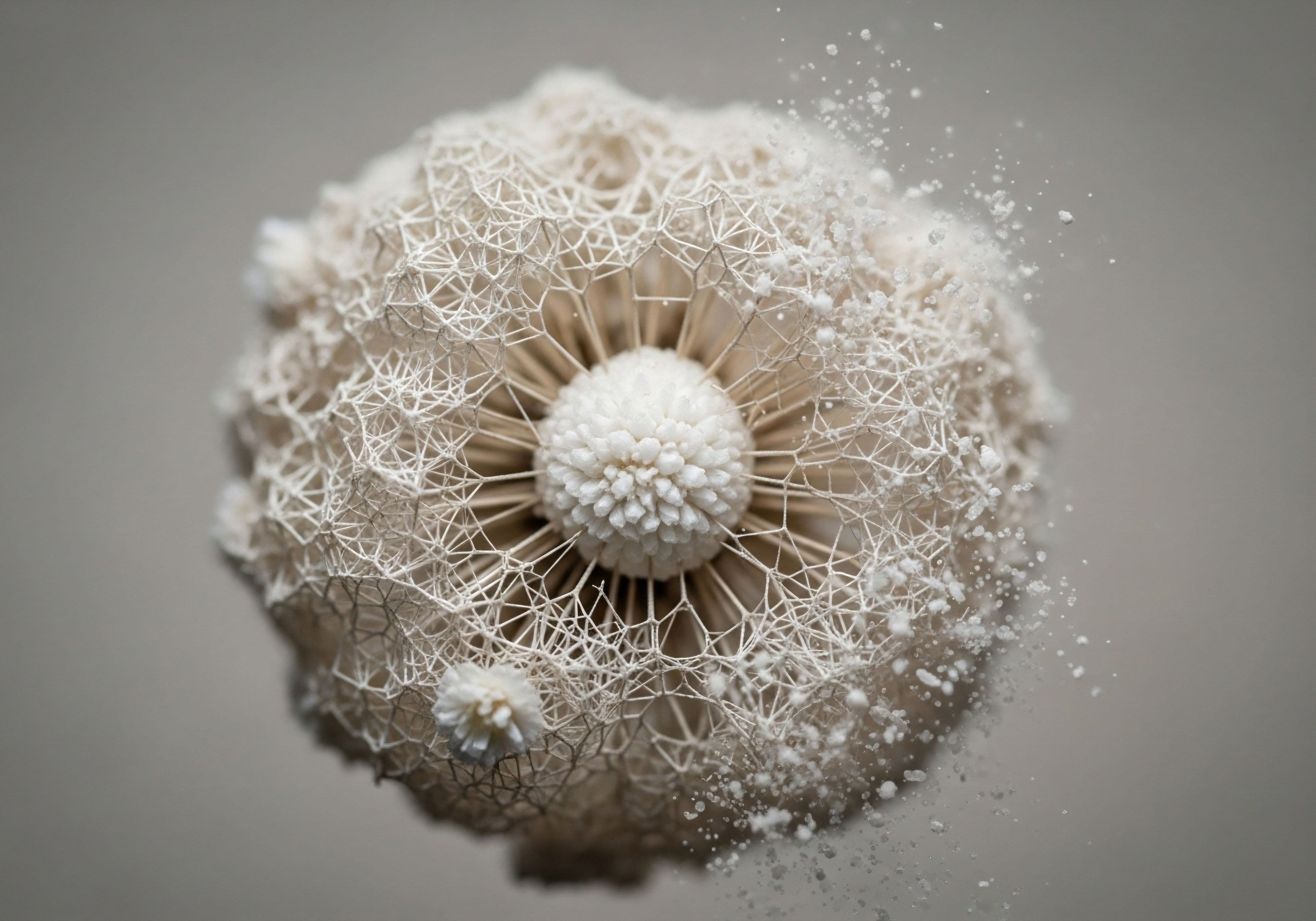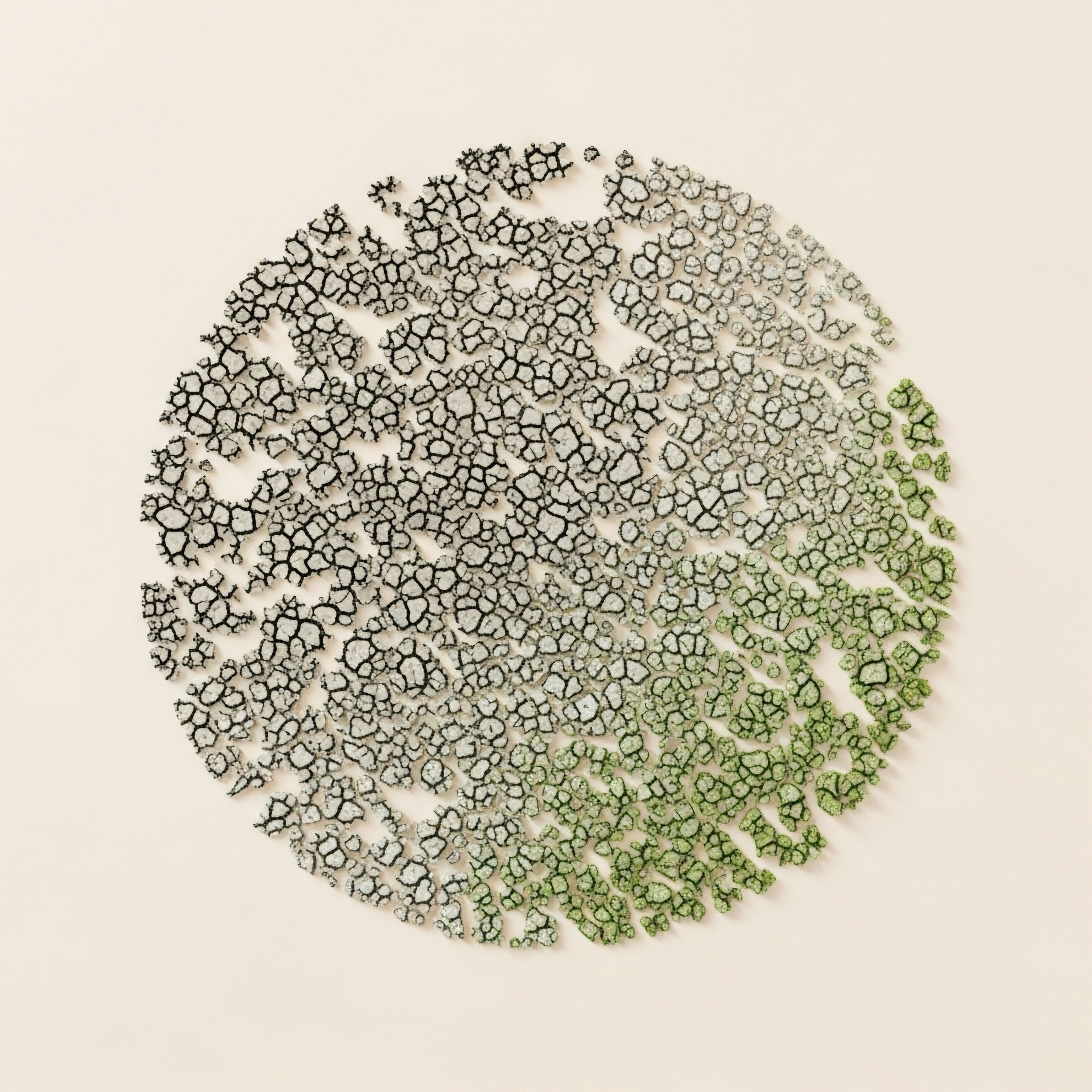

Fundamentals
There is a point in many of our lives when we begin to notice a subtle, yet persistent, shift in the way our bodies recover. The resilience that once felt automatic, the seamless mending of tissues after a strenuous workout or a minor injury, seems to operate on a slower timeline.
This experience is not a failure of will or a sign of inevitable decline. It is a tangible, biological reality rooted in the intricate communication systems that govern our cellular health. The body speaks a language of regeneration, a language composed of precise molecular instructions. Over time, the fluency and clarity of this internal dialogue can diminish. Understanding this language, and how to restore its precision, is the first step toward reclaiming the body’s innate capacity for repair.
At the very heart of this cellular conversation are peptides. These are short chains of amino acids, the fundamental building blocks of proteins. Think of them as the body’s own specialized text messages, each one carrying a clear and concise command for a specific type of cell.
When your body needs to repair a muscle, reduce inflammation, or build new tissue, it dispatches specific peptides to deliver the instructions. These molecules are the directors of the cellular orchestra, ensuring that every biological process happens at the right time and in the right place. They are not foreign substances; they are native to our own physiology, essential components of the machinery that maintains our vitality.
Peptides act as highly specific signaling molecules that instruct cells on how to perform essential functions related to repair and regeneration.
The mechanism by which these molecular messages are received is a process known as cell signaling. Every cell in your body has receptors on its surface, each shaped to receive a particular type of peptide. When a peptide docks with its corresponding receptor, it is like a key fitting perfectly into a lock.
This connection initiates a cascade of biochemical reactions inside the cell, translating the peptide’s message into direct action. This action could be the command to produce more collagen to repair skin and connective tissues, to increase the formation of new blood vessels to nourish a healing area, or to modulate the local immune response to quiet down excessive inflammation. This is the fundamental basis of cellular regeneration.
The influence of peptide therapies on this system is based on providing the body with a clear, amplified signal. By introducing specific peptides that are identical to the ones our bodies naturally use, we can re-establish and enhance the communication that may have become muted.
This is not about forcing the body to do something unnatural. It is about restoring a conversation that is essential for health, providing the clear instructions your cells need to carry out their regenerative tasks with efficiency and precision. The goal is to work with the body’s own systems, empowering them to function at their optimal level. This approach moves us from simply managing symptoms to actively supporting the foundational processes of healing and vitality.


Intermediate
Building upon the understanding of peptides as cellular messengers, we can now examine the clinical application of this science. The world of therapeutic peptides is highly specialized. Different peptides are designed to interact with distinct biological pathways, much like a team of skilled technicians, each with a specific role in a complex project.
A primary focus of regenerative and wellness protocols is the optimization of the Growth Hormone (GH) axis. This system is a central regulator of tissue repair, metabolism, and overall physical function. Think of GH as the master foreman on a construction site, overseeing the work of repair and growth throughout the body.
The release of GH is governed by a sophisticated feedback loop originating in the brain, primarily involving the hypothalamus and the pituitary gland. The hypothalamus releases Growth Hormone-Releasing Hormone (GHRH), which signals the pituitary to produce and release GH. This is a delicate, pulsatile rhythm, with GH levels naturally fluctuating throughout the day and night. Therapeutic peptides in this category work by interacting with this natural system in two distinct ways.

Targeting the Growth Hormone Axis
Two main classes of peptides are used to influence GH production ∞ GHRH analogs and Growth Hormone Releasing Peptides (GHRPs). Each class interacts with the pituitary gland through a different mechanism, and their combined use creates a powerful synergistic effect.
- GHRH Analogs ∞ This class of peptides, which includes substances like Sermorelin and CJC-1295, mimics the body’s own GHRH. They bind to the GHRH receptors on the pituitary gland, prompting it to release its stored growth hormone. It is an action that respects the body’s inherent physiological rhythms.
- GHRPs (or Ghrelin Mimetics) ∞ This class, including peptides like Ipamorelin, works on a different receptor known as the growth hormone secretagogue receptor (GHS-R). This is the same receptor activated by the hormone ghrelin. Activating this pathway also triggers a strong release of GH. One of the key attributes of a peptide like Ipamorelin is its high specificity; it stimulates GH release without significantly affecting other hormones like cortisol or prolactin.
The combination of a GHRH analog and a GHRP is particularly effective. Using an analogy, the GHRH analog gently presses the accelerator for GH release, while the GHRP simultaneously reduces the braking pressure. This dual-action approach leads to a more robust and physiologically natural pulse of growth hormone, greater than what either peptide could achieve on its own.
Combining GHRH and GHRP peptides creates a synergistic effect, leading to a more potent and naturalistic release of growth hormone.

A Comparison of Key Growth Hormone Peptides
To provide greater clarity, it is useful to compare the most common peptides used for influencing the GH axis. Their differences in structure and half-life dictate their clinical application and dosing schedules.
| Peptide | Class | Mechanism of Action | Primary Benefits |
|---|---|---|---|
| Sermorelin | GHRH Analog | Mimics natural GHRH, stimulating a gentle, pulsatile release of GH from the pituitary. It has a very short half-life. | Supports natural GH rhythms, improves sleep quality, and promotes overall wellness with a high safety profile. |
| CJC-1295 (with DAC) | GHRH Analog | A long-acting GHRH analog that binds to plasma albumin, leading to a sustained elevation of GH and IGF-1 levels over several days. | Provides consistent anabolic support, enhances fat loss and muscle gain, and improves tissue repair with infrequent dosing. |
| Ipamorelin | GHRP (Ghrelin Mimetic) | Selectively activates the ghrelin receptor (GHS-R) to induce a strong, clean pulse of GH without affecting cortisol or prolactin. | Promotes lean muscle mass, aids in fat metabolism, and improves recovery and sleep, often used in synergy with CJC-1295. |

Peptides for Direct Tissue Repair
While optimizing the GH axis provides a systemic environment conducive to repair, other peptides are engineered to work directly at the site of injury. These molecules have different mechanisms of action, focusing on the foundational processes of healing.
- BPC-157 ∞ This peptide, a sequence derived from a protein found in the stomach, has demonstrated profound capabilities in tissue regeneration. It is known to accelerate the healing of muscle, tendon, ligament, and bone by promoting the formation of new blood vessels (angiogenesis) and activating the cells responsible for tissue repair.
- PT-141 ∞ This peptide operates through a completely different pathway. It is a melanocortin agonist, working primarily within the central nervous system to influence pathways related to sexual arousal and function. Its mechanism highlights the diverse applications of peptide therapies beyond structural repair.
Understanding these different peptides and their mechanisms allows for the development of highly tailored protocols. A person seeking to improve recovery from a musculoskeletal injury might benefit from a protocol that combines systemic GH optimization with a targeted repair peptide like BPC-157. This strategic approach, grounded in the principles of cellular communication, is the foundation of modern personalized wellness.


Academic
An academic exploration of peptide therapy’s influence on cellular regeneration requires a granular analysis of the molecular mechanisms involved. While systemic hormonal optimization creates a permissive environment for healing, the true work of tissue reconstruction occurs through a complex interplay of local signaling pathways.
The stable gastric pentadecapeptide BPC-157 serves as an exemplary model for dissecting these intricate processes. Its documented efficacy in accelerating the repair of diverse tissues, from tendon to gut mucosa, provides a window into the core components of cellular regeneration.

The Molecular Choreography of BPC 157 in Tissue Repair
Following a soft tissue injury, the local environment is characterized by cellular damage, vascular disruption, and an immediate inflammatory response. The success of the healing process depends on a highly organized sequence of events ∞ inflammation control, angiogenesis (the formation of new blood vessels), and tissue matrix deposition.
BPC-157 appears to intervene at several critical junctures in this cascade. A primary mechanism is its potent pro-angiogenic effect. Studies in animal models have shown that BPC-157 can significantly promote the formation of new blood vessels in injured tissues.
This is partly achieved through the upregulation of Vascular Endothelial Growth Factor (VEGF), a key signaling protein that initiates angiogenesis, and the activation of the endothelial nitric oxide synthase (eNOS) system, which improves blood flow and vessel health. This revascularization is a critical step, as it restores the supply of oxygen and nutrients necessary to fuel the metabolic demands of cellular repair.

How Does BPC 157 Interact with Growth Hormone Signaling?
One of the most compelling aspects of BPC-157’s mechanism is its interaction with the growth hormone (GH) signaling pathway at a local level. While GH is released systemically from the pituitary, its effects are mediated by GH receptors on target cells.
A groundbreaking study demonstrated that BPC-157 can significantly increase the expression of the growth hormone receptor (GHR) in tendon fibroblasts. This finding is of profound importance. It suggests that BPC-157 acts as a sensitizing agent, making the repair cells (fibroblasts) more responsive to the body’s own circulating growth hormone.
This upregulation of GHR means that even normal physiological levels of GH can have a more potent anabolic and reparative effect at the site of injury. It creates a synergistic link between the systemic endocrine environment and local tissue-level repair processes.
BPC-157 enhances tissue regeneration by upregulating local growth hormone receptors, making repair cells more sensitive to the body’s natural healing signals.
This mechanism effectively primes the injured tissue for reconstruction. Fibroblasts, the primary cells responsible for producing collagen and other extracellular matrix proteins, are the architects of tissue repair. By increasing their sensitivity to GH, BPC-157 enhances their proliferation and migratory capacity, allowing them to populate the wound site more effectively and begin laying down a new structural scaffold. This is supported by research showing BPC-157 accelerates the outgrowth of tendon fibroblasts from explants, a direct measure of its regenerative stimulus.

Mechanistic Actions of BPC 157 in Cellular Regeneration
The multifaceted nature of BPC-157’s action is what makes it such a powerful agent for regeneration. It does not rely on a single pathway but orchestrates a coordinated response to injury.
| Mechanistic Action | Biological Process | Cellular Outcome |
|---|---|---|
| Pro-Angiogenic Signaling | Upregulates VEGF and activates eNOS pathways. | Accelerated formation of new blood vessels, improved blood flow, and enhanced delivery of oxygen and nutrients to the injury site. |
| GHR Upregulation | Increases the density of Growth Hormone Receptors on tendon fibroblasts. | Heightens the sensitivity of repair cells to circulating GH, amplifying the anabolic and proliferative signals for tissue reconstruction. |
| Fibroblast Activation | Promotes the survival, proliferation, and migration of fibroblasts. | Faster wound closure and more organized deposition of collagen and extracellular matrix, leading to stronger, more functional repaired tissue. |
| Inflammatory Modulation | Attenuates excessive inflammatory responses without impairing the healing process. | Reduces secondary tissue damage from chronic inflammation and creates a more favorable environment for orderly tissue repair. |
In conclusion, the influence of a peptide like BPC-157 on cellular regeneration is a clear demonstration of systems biology in action. It acts locally to improve blood supply, directly stimulates the key cells responsible for repair, and crucially, it amplifies the tissue’s receptivity to the body’s systemic anabolic signals.
This sophisticated, multi-pronged approach explains its broad efficacy and positions such peptides as a cornerstone of advanced regenerative medicine protocols. Further research will continue to unravel these complex interactions, offering even more precise therapeutic strategies in the future.

References
- Seiwerth, S. et al. “Stable gastric pentadecapeptide BPC 157 and wound healing.” Frontiers in Pharmacology, vol. 12, 2021, p. 627533.
- Chang, C. H. et al. “Pentadecapeptide BPC 157 enhances the growth hormone receptor expression in tendon fibroblasts.” Molecules, vol. 19, no. 11, 2014, pp. 19066-77.
- Teixeira, L. S. et al. “Prolonged stimulation of growth hormone (GH) and insulin-like growth factor I secretion by CJC-1295, a long-acting analog of GH-releasing hormone, in healthy adults.” The Journal of Clinical Endocrinology & Metabolism, vol. 91, no. 3, 2006, pp. 799-805.
- Raun, K. et al. “Ipamorelin, the first selective growth hormone secretagogue.” European Journal of Endocrinology, vol. 139, no. 5, 1998, pp. 552-61.
- Ionescu, M. and L. A. Frohman. “Pulsatile secretion of growth hormone (GH) persists during continuous stimulation by CJC-1295, a long-acting GH-releasing hormone analog.” The Journal of Clinical Endocrinology & Metabolism, vol. 91, no. 12, 2006, pp. 4792-7.
- Hsieh, M. J. et al. “Therapeutic potential of pro-angiogenic BPC157 is associated with VEGFR2 activation and up-regulation.” Journal of Molecular Medicine, vol. 95, no. 6, 2017, pp. 657-667.
- Chang, C. H. et al. “The promoting effect of pentadecapeptide BPC 157 on tendon healing involves tendon outgrowth, cell survival, and cell migration.” Journal of Applied Physiology, vol. 110, no. 3, 2011, pp. 774-80.
- Walker, R. F. “Sermorelin ∞ a better approach to management of adult-onset growth hormone insufficiency?” Clinical Interventions in Aging, vol. 1, no. 4, 2006, pp. 307-8.

Reflection
The information presented here provides a map of the biological territories that govern your body’s capacity for renewal. This knowledge is a powerful tool, shifting the perspective from one of passive endurance to one of active participation in your own health.
The language of your cells is not a foreign dialect; it is the intrinsic operating system of your own physiology. Understanding its grammar and vocabulary is the foundational step. As you consider your own experiences with recovery, energy, and vitality, reflect on this internal communication. The journey toward sustained well-being begins with this deeper awareness, opening up a dialogue with your own biology and illuminating the path toward personalized, proactive care.



